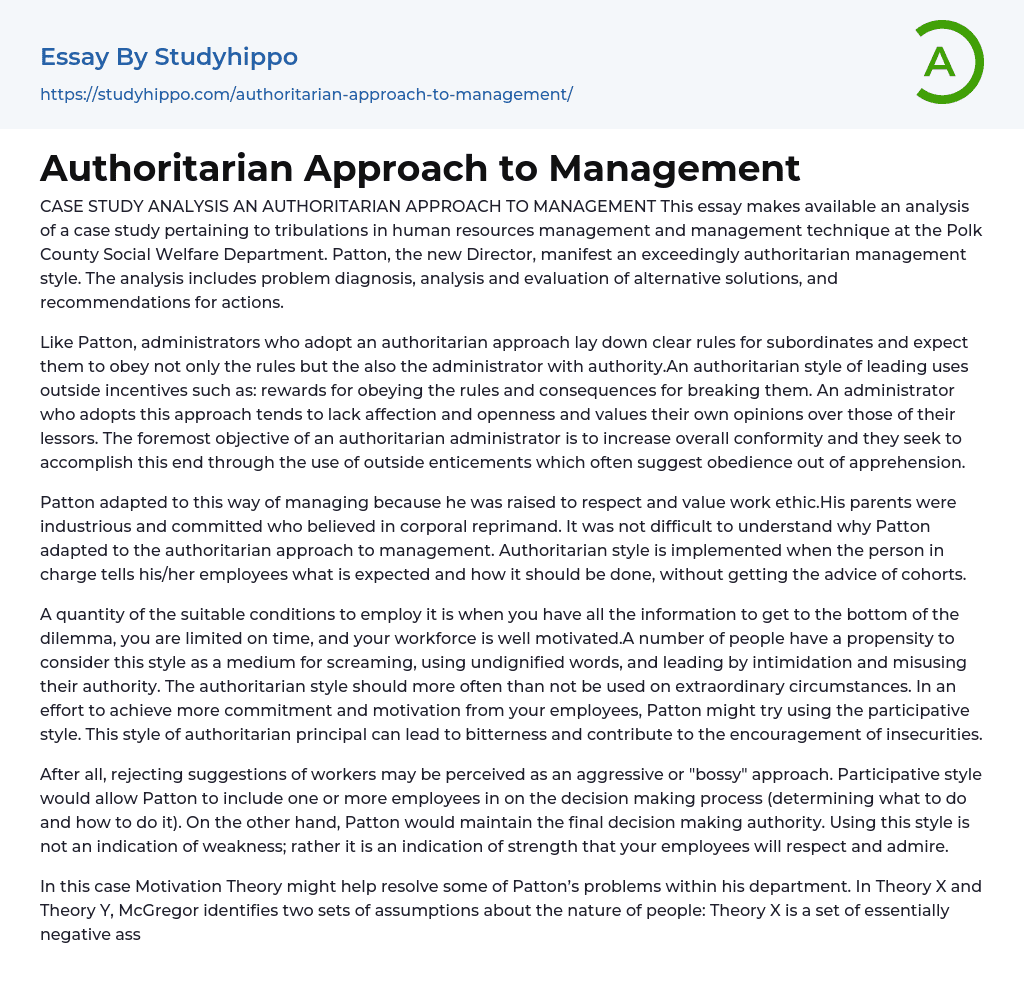This essay makes available an analysis of a case study pertaining to tribulations in human resources management and management technique at the Polk County Social Welfare Department. Patton, the new Director, manifest an exceedingly authoritarian management style. The analysis includes problem diagnosis, analysis and evaluation of alternative solutions, and recommendations for actions.
Like Patton, administrators who adopt an authoritarian approach lay down clear rules for subordinates and expect them to obey not only the rules but the also the administrator with authority.An authoritarian style of leading uses outside incentives such as: rewards for obeying the rules and consequences for breaking them. An administrator who adopts this approach tends to lack affection and openness and values their own opinions over those of their lessors. The foremost objective of an authoritarian administrat
...or is to increase overall conformity and they seek to accomplish this end through the use of outside enticements which often suggest obedience out of apprehension.
Patton adapted to this way of managing because he was raised to respect and value work ethic. His parents were industrious and committed who believed in corporal reprimand. It was not difficult to understand why Patton adapted to the authoritarian approach to management. Authoritarian style is implemented when the person in charge tells his/her employees what is expected and how it should be done, without getting the advice of cohorts.
A quantity of the suitable conditions to employ it is when you have all the information to get to the bottom of the dilemma, you are limited on time, and your workforce is well motivated.A number of people have a propensity to consider this style as a medium for screaming, using undignified words,
and leading by intimidation and misusing their authority. The authoritarian style should more often than not be used on extraordinary circumstances. In an effort to achieve more commitment and motivation from your employees, Patton might try using the participative style. This style of authoritarian principal can lead to bitterness and contribute to the encouragement of insecurities.
After all, rejecting suggestions of workers may be perceived as an aggressive or "bossy" approach. Participative style would allow Patton to include one or more employees in on the decision making process (determining what to do and how to do it). On the other hand, Patton would maintain the final decision making authority. Using this style is not an indication of weakness; rather it is an indication of strength that your employees will respect and admire.
In this case Motivation Theory might help resolve some of Patton’s problems within his department. In Theory X and Theory Y, McGregor identifies two sets of assumptions about the nature of people: Theory X is a set of essentially negative assumptions about the nature of people and Theory Y is a set of positive assumptions about the nature of people. McGregor’s XY Theory is a valuable and undemanding reminder of the natural rules for managing people, which under the heaviness of everyday business are all too without difficulty elapsed.In lieu of the information presented in this analysis, conceivably the most evident characteristics of McGregor's XY Theory - and the easiest to exemplify - are found in the behaviors of autocratic managers and organizations which use autocratic management styles such as Patton did in his role as a manager.
It is part of the manager’s job to
exercise authority, and there are cases in which this is the only method of achieving the desired results because subordinates do not agree that the ends are desirable.In reality, some theories are unrealizable in practice, but if managers put into action that employee will contribute to the organizational goals if they are treated as responsible and valued employees.
Qualitative and Quantitative analysis can both be used in this situation; however, there are pros and cons associated with each taking into consideration the two types of data analysis form dissimilar, not compulsory, irreconcilable perspectives on quantity statistics. Nonetheless, I think that qualitative analysis is an absolute detailed description which allows for superior distinctions to be drawn.
Likewise, a lack of understanding of practice organization and function has limited the effectiveness of attempts to change practice behaviors. Therefore, a qualitative analysis might be used with a cross-sectional study or multimethod approach that included direct observation of managers within the public welfare agency, questionnaires of employes, and semistructured participant observation of the organization.
The goals of the qualitative component of the study might be to recognize and demonstrate the barriers to nd the opportunities for successful and well-organized management approaches. Finally, the extent to which leaders are able to manage change, develop consensus, and maintain loyalty will establish the success/failure of any organizational management idea or reorganization endeavor. One of the most noteworthy factors that impede success in organizations is lack of leadership. Continuous, attentiveness, self-evident leadership is very important for flourishing achievement of organizational change.
- Being A Leader essays
- Servant Leadership essays
- Leadership Experience essays
- Leadership Qualities essays
- Board Of Directors essays
- Brand Management essays
- Business Ethics essays
- Business Management essays
- Change Management essays
- Comparative Analysis essays
- Decision Making essays
- Dispute Resolution essays
- Knowledge Management essays
- Leadership essays
- Leadership and Management essays
- Manager essays
- Operations Management essays
- Performance Management essays
- Product Management essays
- Project Management essays
- Quality Management essays
- Risk essays
- Risk Management essays
- Scientific Management essays
- Stress Management essays
- supply chain management essays
- Time Management essays
- Total Quality Management essays
- Experiment essays
- Explorer essays
- Hypothesis essays
- Observation essays
- Qualitative Research essays
- Research Methods essays
- Theory essays




